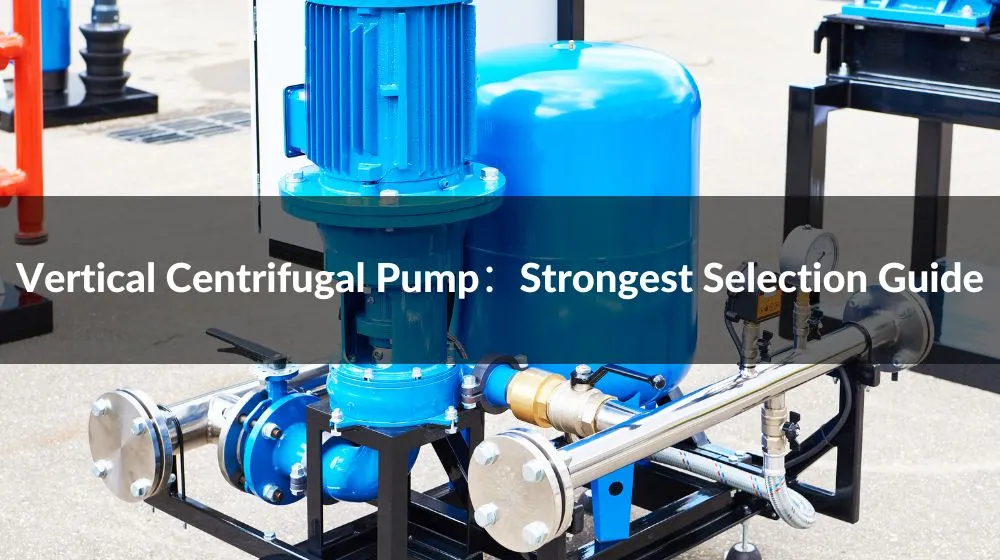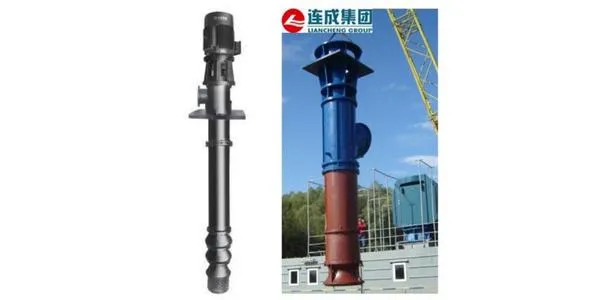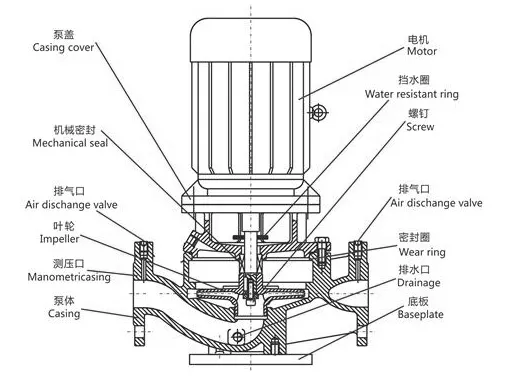


Vertical centrifugal pumps play an important role in many industrial and commercial applications. Selecting the proper vertical centrifugal pump is critical to the effectiveness of fluid transfer and handling. This guide has been designed to provide you with key information and practical advice to help you make an informed choice among the many options to ensure you are choosing the right quality pump for your needs.
A vertical centrifugal pump is a type of pump that is driven by centrifugal force, and its axis is perpendicular to the horizontal plane. It sucks in the liquid through the rotating motion of the impeller and throws it out at high speed to realize the pumping of the liquid. A vertical centrifugal pump usually consists of a motor, a pump body, an impeller, and a sealing device. The characteristics of the vertical centrifugal pump are as follows:
Vertical installation: The pump body of the vertical centrifugal pump is placed vertically, and the inlet and outlet positions are usually located at the top and bottom of the pump body. This vertical arrangement makes the installation of the pump more flexible and adaptable, and can provide a larger flow rate and head in the case of limited space.
Multiple applications: Vertical centrifugal pumps are suitable for many different applications, including industrial production, building water supply, drainage treatment, agricultural irrigation, etc. They can handle various media, such as clean water, sewage, chemical liquids and corrosive liquids, etc.
Simple structure: The structure of a vertical centrifugal pump is relatively simple, usually consisting of a small number of components. This makes pump installation and maintenance easier, reducing maintenance complexity and costs.
Efficient and stable: Vertical centrifugal pumps can provide efficient pumping performance with high flow and pressure. Its operation is stable and reliable, and can meet the needs of long-term continuous work.
Vertical centrifugal pumps transfer the mechanical energy of the prime mover to the liquid by rotating the impeller. As the liquid flows from the inlet to the outlet of the impeller, its velocity and pressure energy increase. The impeller pushes the liquid into the extruder cavity, where most of the velocity is converted to pressure energy, which is then transported down the discharge pipe. At the same time, a vacuum or low-pressure area is formed at the impeller inlet, and the liquid in the pool is sucked into the impeller inlet due to the pressure on the liquid surface and the atmospheric pressure. This allows the rotating impeller to continuously suck in and expel liquid.
Pump body: The pump body of a vertical centrifugal pump is usually made of metal materials (such as cast iron, stainless steel) or alloy materials, which have good strength and corrosion resistance. The pump body is usually cylindrical in shape and has a stable structure to withstand the working pressure and weight of the pump.
Impeller: The impeller of a vertical centrifugal pump is the key working part and is usually made of metallic materials such as cast iron, stainless steel or copper alloys. The impeller can be designed in various forms and can be open impeller, semi-open impeller or closed impeller. There are usually multiple blades on the impeller, and the design of their shape and angle has a significant impact on the performance of the pump.
Pump shaft: The pump shaft is a key component connecting the motor and impeller, usually made of high-strength alloy steel. The pump shaft needs to be strong and rigid enough to withstand the rotational force of the impeller and the working load of the pump. The quality and machining accuracy of the pump shaft have an important impact on the smooth operation and life of the pump.
Sealing device: The sealing device of the vertical centrifugal pump is used to prevent liquid leakage. Common sealing forms include packing seals, mechanical seals and magnetic seals. The packing seal uses packing (such as soft graphite, polytetrafluoroethylene, etc.) to fill the gap between the pump body and the pump shaft to form a seal. Mechanical seals prevent liquid leakage through mechanical sealing devices. The magnetic seal achieves a non-contact sealing effect through magnetic force.
Import and export pipes: The import and export pipes of vertical centrifugal pumps are used to connect the pump body and external systems. The inlet pipe is usually located at the top of the pump body for liquid entry; the outlet pipe is located at the bottom or side of the pump body for liquid discharge. The design of the pipeline should consider the resistance of fluid flow and pressure loss to ensure the pumping efficiency and performance of the pump.
Motor and Drive: Vertical centrifugal pumps typically use an electric motor as the drive to transmit rotational power to the pump shaft and impeller. The motor is usually installed on the upper part of the pump body and connected with the pump shaft through a flexible coupling. The power and speed of the motor should be reasonably selected according to the working requirements of the pump and the nature of the liquid.
Brackets and pedestals: Vertical centrifugal pumps usually require brackets and pedestals to support and secure the pump body, motor, and other components. The design of the bracket and base should consider the stability and reliability of the pump, as well as the convenience of installation, maintenance and inspection.

Determine the demand: first figure out what the liquid you need to pump is and what the working conditions are, such as temperature, concentration, etc.
Flow calculation: According to the actual demand, calculate the required liquid flow, that is, the amount of liquid passing through the pump per unit time.
Head calculation: Calculate the required head, that is, the resistance height difference that needs to be overcome when the liquid is pumped.
Check the performance curve: Find the performance curve of the selected pump to see how the pump works under different flow rates and heads.
Find the matching point: According to the calculation results of the flow rate and head, find the appropriate working point on the performance curve, that is, the point that can meet the demand.
Determine the pump type: Select the appropriate pump type according to the actual situation, including considering the pump material, sealing method, motor power and other factors.
Temperature: Determine the fluid temperature range for the working environment. Some liquids may have high or low temperature characteristics, so it is necessary to select pump materials and seal forms suitable for this temperature range.
Pressure: Understand the pressure of fluids in your work environment. Some applications may require the pump to be able to withstand high pressures, so a pump body and seals of sufficient strength need to be selected.
Corrosivity: Determines how corrosive the liquid is to the pump material. Some liquids may be corrosive, so it is necessary to choose corrosion-resistant materials, such as stainless steel or alloy materials.
Fluid properties: Understand the properties of liquids such as viscosity and particle content. High-viscosity liquids may require stronger drive forces and pump designs, while liquids with high particle content may require special filtration or cleaning.
Environmental Conditions: Consider the physical conditions of the work environment, such as vibration, humidity, and space constraints. Some application scenarios may have large vibration or humidity, so it is necessary to choose a pump type with shock resistance and moisture resistance.
Safety Requirements: Understand the safety requirements of the work environment. Some special industries or environments may have specific requirements on the safety and explosion-proof performance of the pump, and it is necessary to select a pump type that meets the corresponding standards.
Stainless Steel: Stainless steel is a commonly used pump material with excellent corrosion resistance. Different grades of stainless steel are available to handle various acids, bases, salts and corrosive liquids.
Nickel-Based Alloys: Nickel-Based Alloys have excellent corrosion resistance and are especially suitable for handling acidic media and high-temperature environments. Common nickel-based alloys include Monel and Hastelloy.
Polypropylene: Polypropylene is a corrosion-resistant plastic material commonly used to handle acidic solutions, corrosive gases, and some organic solvents.
Polytetrafluoroethylene (PTFE): PTFE is an excellent non-metallic material with excellent corrosion resistance and anti-adhesion properties. It is often used to deal with strong acid, strong alkali and high temperature medium.
Corrosion-Resistant Coatings: In some cases, the basic material of the pump may not have sufficient corrosion resistance, so corrosion-resistant coatings can be used to improve the corrosion resistance of the pump. Common coating materials include fluoroplastic coatings and rubber coatings.
Efficiency: The efficiency of a vertical centrifugal pump is the ratio between the input power converted by the pump and the output fluid energy. High-efficiency pumps produce the required flow and head with less energy loss. When selecting a pump, attention should be paid to its efficiency index, and a pump type with high efficiency should be selected.
Design and Manufacturing: The quality of a pump's design and manufacture has a major impact on its efficiency. Reasonable impeller design, optimized flow channel structure, reduction of internal friction and loss, etc., can all improve the efficiency of the pump. In addition, the selection of high-quality materials and precise manufacturing processes can also improve the efficiency and reliability of the pump.
Working point matching: Vertical centrifugal pumps usually have an optimal working point on the working curve, that is, the point where they can run at the highest efficiency. In practical application, the appropriate pump type and size should be selected according to the demand, so that it can operate near the optimal working point to improve efficiency and reduce energy consumption.
Control system: Adopt advanced control system, such as frequency converter, can adjust the speed and power output of the pump according to actual needs. Through the control system, the operating state of the pump can be adjusted according to flow changes and process requirements, so as to reduce energy consumption and improve energy utilization efficiency.
Maintenance and Maintenance: Regular maintenance and maintenance can ensure the normal operation and efficient performance of vertical centrifugal pumps. Regular inspection and cleaning of pump components, replacement of worn parts, adjustment of fasteners, etc., can reduce the friction loss and energy consumption of the pump, and prolong the service life of the pump.
Check the working status of the pump: Regularly check the running status of the pump, including parameters such as speed, vibration, temperature, etc., to ensure the normal operation of the pump. If abnormalities are found, measures should be taken to repair or adjust in time.
Clean the pump body and screen: Regularly clean the inside and outside of the pump body for dirt and buildup, especially the impeller and the filter screen at the inlet. This prevents clogging and loss of efficiency of the pump.
Check seals and bearings: Periodically check the pump seals and bearings for wear. If necessary, replace worn seals and bearings in time to ensure the tightness and stability of the pump.
Adjustment and Calibration: Regularly check and adjust the key components of the pump, such as the alignment of the impeller and shaft, and the connection of the pump's inlet and outlet pipes. This helps reduce pump vibration and energy consumption.
Lubrication and liquid level inspection: Regularly check the lubrication of the pump to ensure sufficient lubricant and normal operation. At the same time, check the liquid level to ensure the normal supply and discharge of the pump.
Records and monitoring: establish pump maintenance records, and regularly monitor pump operating data, such as flow, head, energy consumption, etc. This helps to detect potential problems in time and take preventive measures.
Operating costs: The operating costs of a vertical centrifugal pump include energy consumption, maintenance costs and possible breakdown repairs. Choosing a high-efficiency pump can reduce energy consumption, thereby reducing operating costs. In addition, regular maintenance and maintenance can reduce failure rates and repair costs.
Return on Investment: When purchasing a vertical centrifugal pump, it is necessary to evaluate its return on investment. This involves considering the price of the pump, estimated run time, energy costs and maintenance costs. By comprehensively evaluating these factors, the return on investment period and economic benefits of the pump can be estimated.
Flow Test: Using a suitable flow meter, measure the flow output of the vertical centrifugal pump. Run the pump under various load conditions and record the corresponding flow data. Compare to the design flow to ensure the flow output of the pump is as expected.
Head Test: Use a pressure gauge or pressure sensor to measure the head of the vertical centrifugal pump under different load conditions. Run the pump under different working conditions, and record the corresponding head data. Compare with the design head to verify whether the head performance of the pump meets the requirements.
Power Test: Using a power meter or ammeter, measure the input power of the vertical centrifugal pump. Record the input power data of the pump under various load conditions and compare with the design value. This can help determine the energy consumption and efficiency of the pump.
Vibration And Noise Testing: Vibration and noise testing of vertical centrifugal pumps using vibration meters and noise meters. By detecting the vibration level and noise level of the pump, the operating state and mechanical performance of the pump can be evaluated.
Sealing Test: Check the sealing performance of the vertical centrifugal pump to ensure that the pump seals, shaft seals and other components work normally and can effectively prevent leakage.
Temperature Rise Test: Evaluate the thermal effect of the pump by measuring the temperature difference between the inlet and outlet of the pump. This helps to determine the heat loss and efficiency of the pump and to verify the thermal performance of the pump.
Choosing a reliable supplier to buy vertical centrifugal pumps is the key to ensure product quality and after-sales service. Reputation reputation, experience expertise, product quality, technical support after-sales service, price delivery time, and references and recommendations are factors that need to be considered when selecting a supplier. Among many vertical centrifugal pump manufacturers, LIANCHENG GROUP is a recommended supplier. The company has an excellent reputation and a good reputation, and has been committed to the manufacture and supply of vertical centrifugal pumps for many years. They have rich experience and professional knowledge, and have a high level of professional ability in product design, production and quality control.
A vertical centrifugal pump is a commonly used pump type featuring a vertical arrangement for a variety of industrial and commercial applications. When selecting a vertical centrifugal pump, it is necessary to consider the flow and head requirements to ensure that the performance of the pump can meet the actual process requirements. The working environment is also very important to the selection of the pump, considering the nature of the medium, temperature, pressure and other factors, and choosing a pump made of corrosion-resistant materials.
Pump efficiency and energy consumption are key considerations in terms of economy and energy consumption, and choosing a high-efficiency pump can reduce operating costs. Maintenance and maintenance requirements are factors that must be considered when selecting a vertical centrifugal pump to ensure pump reliability and prolong service life. Consider the return on investment and operating costs, and comprehensively consider the price, performance, energy consumption and other factors of the pump to obtain the best investment benefits.
Finally, choosing a reliable supplier for purchase is the key to guarantee product quality and after-sales service, LIANCHENG GROUP is a vertical centrifugal pump manufacturer worth considering.
.png)

